Aadya Baoni
|
December 29, 2025
|
9
min read
Gujarat’s stepwells are reservoirs of ancient water wisdom and meticulous design
These climate-smart ancient structures have lessons for India’s present and future
Read More
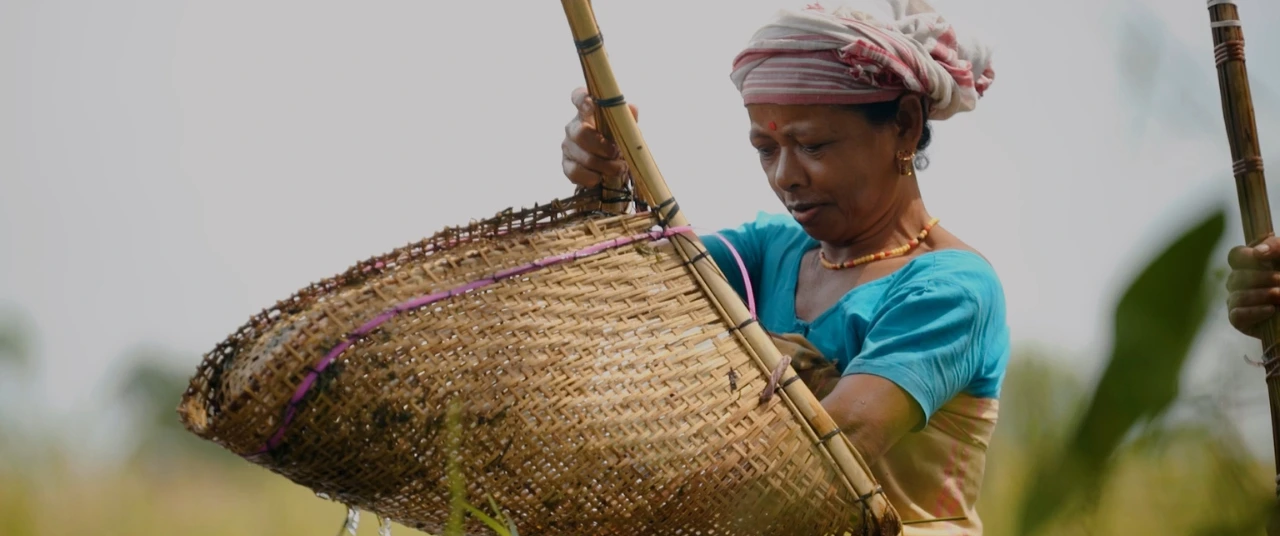
Pungent, fermented Namsing, made in flood-prone regions surrounding Kaziranga, is a reliable protein source even in the bleakest times
Across India’s northeast, fermented foods are considered not just delicacies, but also vital sources of nutrition. Indigenous communities in the region source foods from the fragile, biodiverse surroundings, and use their traditional knowledge to preserve produce for years—ensuring food security during even the most precarious times. As many as 250 different fermented foods are prepared and consumed by these communities.
Holding up these food cultures are traditional knowledge systems that protect those who defer to them as well as their way of life. The communities’ intimate understanding of their surroundings is the basis and foundation of these traditional knowledge systems.
One example of such fermented foods is Namsing, prepared by the Mising community, which is primarily native to the regions of upper Assam. Namsing is a fermented fish paste that emerges from the age-old wisdom of preserving different kinds of foods through smoking; this process of fermentation makes the paste easily last for two years.
Nets are cast right at the doorstep of homes, and yet, there is enough fish to last an entire month.
The Mising community thrives in the undulated riverine landscapes drained by numerous rivers and water bodies. Beloguri is a village in Agoratoli situated on the edge of the eastern range of Kaziranga National Park and Tiger Reserve; here, the community prepares fresh batches of Namsing. At community elder Numal Kardong’s house, his wife Muguri is excited to demonstrate how the fish paste is made.
{{marquee}}
In a year of normal monsoon, torrential rains flood Beloguri and its environs, starting from April all the way to October. “When the rains arrive, fish migrate to the smaller streams, beels (lakes) and ponds to lay their eggs. During the latter part of the monsoon, the hatchlings start to move back to the larger stretches of the rivers. Fish is abundant in this period. During peak floods, you will even find them swimming below my home,” explains Kardong. Due to Assam’s unique riverine landscape, the Mising live in houses that stand on stilts, protecting them from floods. The architecture of these stilt houses or chang ghar—or simply, chang—centres the hearth (meram), where the fish is smoked before being fermented.
Namsing is a fermented fish paste that emerges from the age-old wisdom of preserving different kinds of foods through smoking
Namsing relies on the availability of hatchlings—the young of freshwater carps, barbs, and other smaller varieties of riverine fish. The mix of species used can vary depending on location, but the Mising people usually do not prepare the paste with big fish. A group of fisheries’ industries experts studying the nutritional value of Namsing in 2013 underlined the logic behind selecting small fishes.
“Trash fish (the smaller fish) are highly perishable in nature due to their neutral pH content, and they also fall prey to microbial attacks. In the monsoon season, high valued big fish become comparatively cheaper due to increased supply in the market,” states a 2013 report published by Indian Council of Agricultural Research (ICAR) scientists in the Indian Journal of Traditional Knowledge (IJTK). “Consequently, people opt for bigger fish for fresh consumption and there is a glut of small fish. These fish naturally are preserved for the lean seasons.”
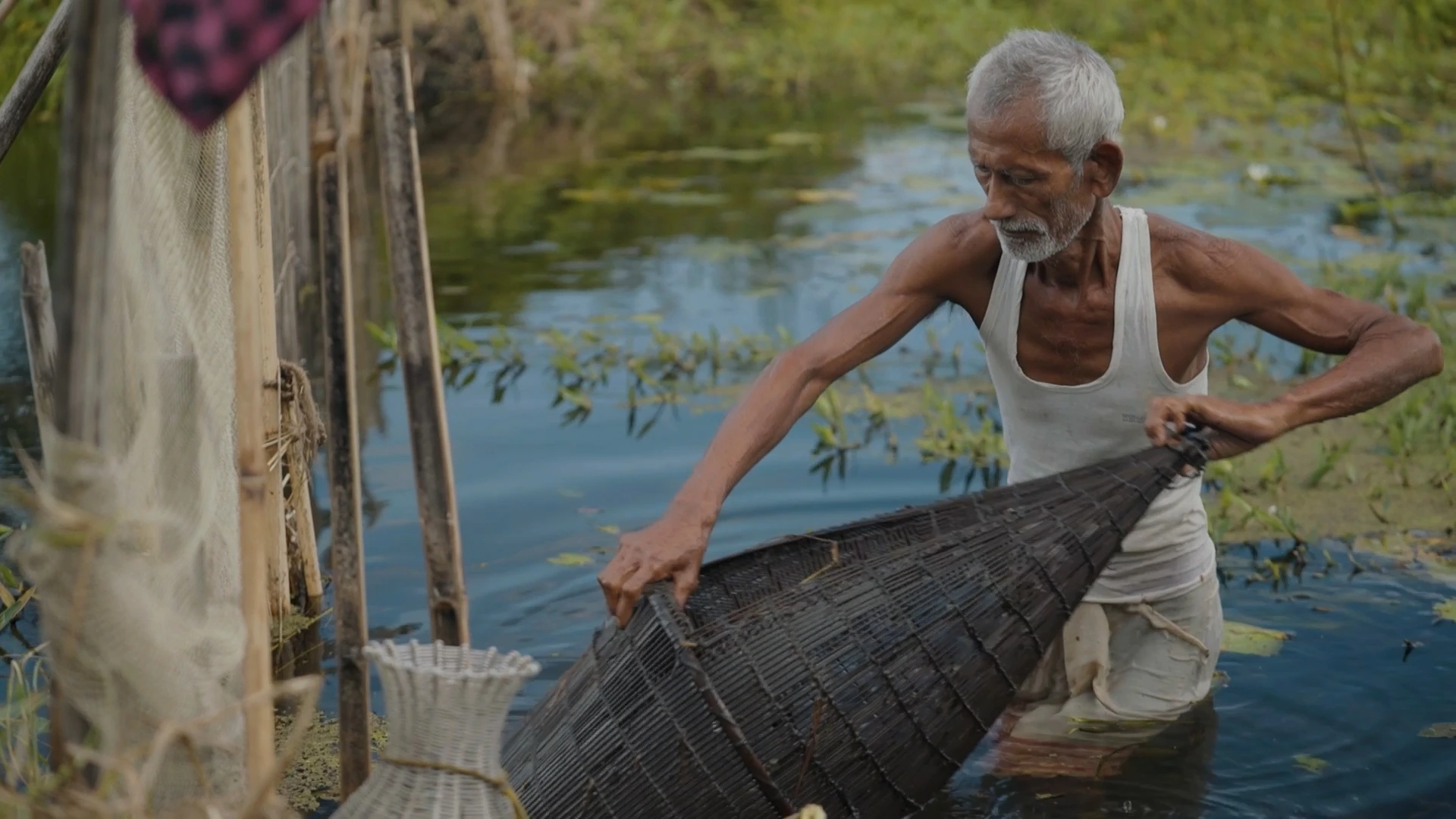
The fish could come from various sources, and during times of flood, one does not have to venture out into the water to catch them. Nets are cast right at the doorstep of homes, and yet, there is enough fish to last an entire month. After the monsoon, when the waters recede, a rivulet or even a paddy field will provide plenty of fish—enough to make several batches of Namsing.
Fishing remains a community activity throughout the rainy season. It starts with the sowing of Bao dhan or deep water rice, an indigenous variety of red rice known for its flood resistance. Since this rice can withstand deep levels of water immersion for extended periods, Bao paddy fields are a natural habitat for several varieties of fish, particularly carps. Numal does not go far and by sundown, he sets the Sepa—a kind of trap to catch fish—in a water body right next to his house. The smaller of these water bodies, including parts of wetlands, are separated by temporary bamboo barricades with openings. When the fish move between the barricades, the Sepa, a bi-conical cylindrical-shaped tool made of bamboo, traps the fish.
By dawn, Numal has enough for his home; his son and neighbours could still fetch the remainder of the catch and take it to the market. When the women fish, they usually use a triangular-shaped tool (also made of bamboo) called Jakoi that is used to scoop out the fish from shallow pools in the smaller wetlands. Muguri, along with her neighbour and other Mising women, swiftly divide chores among themselves and start the process of preparing the Namsing.

Also read: The uncertain future of Aarey Forest’s tribal agriculture
The catch is collected in a woven bamboo basket called Khaloi, one of the most common fishing tools among small fishers across Assam. Each fish is degutted, cleaned with salt water and put out in the sun for three or four days on a Chaloni or bamboo sieve. Community elders say that the sharp sun of the post-monsoon is best suited to dry the catch. At night, the Chaloni is brought to the hearth and smoked on a Perup—a hanging platform made of bamboo—at the height of four or five feet above the hearth.

When the smoked and dried fish hardens, it is time to grind it to a paste. The ground fish is combined with local herbs—a mix that typically consists of the leaves of taro, ferns, sponge gourd and turmeric. Muguri’s backyard has all the ingredients except the Bihlongoni or the ferns, which, luckily, are growing close to the water bodies. While the fish was being smoked and sun-dried, she had collected the herbs and let them out to dry in the sun, too. To make her Namsing, she adds Eagle Ferns (Ptridium aquilinum), known to repel insects during the fermentation stage. Taro leaves or Kosu paat (Colocasia esculenta) add body to the mix and aid in fermentation; additionally, locals say that Taro leaves may have benefits for people suffering from anaemia and poor digestion, and who seek relief from pain. Their knowledge broadly matches the findings of various pharmacological studies.
Siju or Indian spurge leaves (Euphorbia neriifolia) are considered beneficial for respiratory disorders, and are believed to relieve jaundice symptoms. Muguri also collects Sponge gourd leaves or Vol from her backyard—known for their anti-cancer properties and used by the community to treat ulcers as well as to relieve pain. Halodhi or turmeric leaves are added for their ability to cure indigestion and heal wounds.

Like fishing, the process of grinding and packing Namsing, too, is a communal activity. Numal identifies an immature bamboo shoot and removes an internode to make chunga or bamboo tubes, which will shortly be used for storing the paste. His young grandnephew, Ritupan Pegu—who also works as a local guide at the Kaziranga National Park—sources a haat-dheki, a traditional husking and grinding tool from the neighbours. Carved out of a large tree stump, haat-dhekis are operated by hand and used to grind staples like rice. The community’s women gather at the Kardong courtyard and prepare the grinder. Muguri first adds in the dried and smoked fish, which is followed by the foraged leaves. She also adds turmeric powder, green chillies and finally, some Beeh jolokia—a fiery local chilly.
Soon, the Kardong courtyard is enveloped in sound: the light thuds of the haat-dheki, where fish mixed with herbs and spices is slowly mashed until it folds together as a coarse paste. The women then stuff the bamboo tube with the paste. A fresh Taro leaf is wrapped around the paste inside the tube, to ward off insects lured by the smell. Next, they use paddy straws to seal the Namsing inside the tube. The paddy straw works as an insulator and provides cushioning when the Namsing expands during fermentation, producing gases like ammonia. Finally, the bamboo tube is fastened firmly with clay, which acts as a sturdy seal to prevent any leakage or insect attacks. The fish-filled bamboo tubes are then placed at the Perup above the hearth in the kitchen, which remains free of any kind of infestation throughout the year.
Also read: In Meghalaya, Mei Ramew cafés keep indigenous recipes, techniques alive
Muguri maintains that the mix will be ready in a month or so. During this process, as research shows, the protein content of the fish barely changes, while lipids or fish fats are lost even before paste-making or fermentation to the process of smoking and drying. Mineral analysis of Namsing has shown an increased proportion of calcium, magnesium, potassium, and manganese in the fermented paste than that in raw fish. Experts who have studied Namsing have found the smoking, drying and fermentation process to aid the increase in these crucial nutrients.
When these villages are swamped by floodwater from Kaziranga, a tube of Namsing is finally opened and mixed with steamed rice for a hearty meal. Likewise, during lean months when the fish catch reduces, Namsing becomes the cheapest protein source for the Mising families.
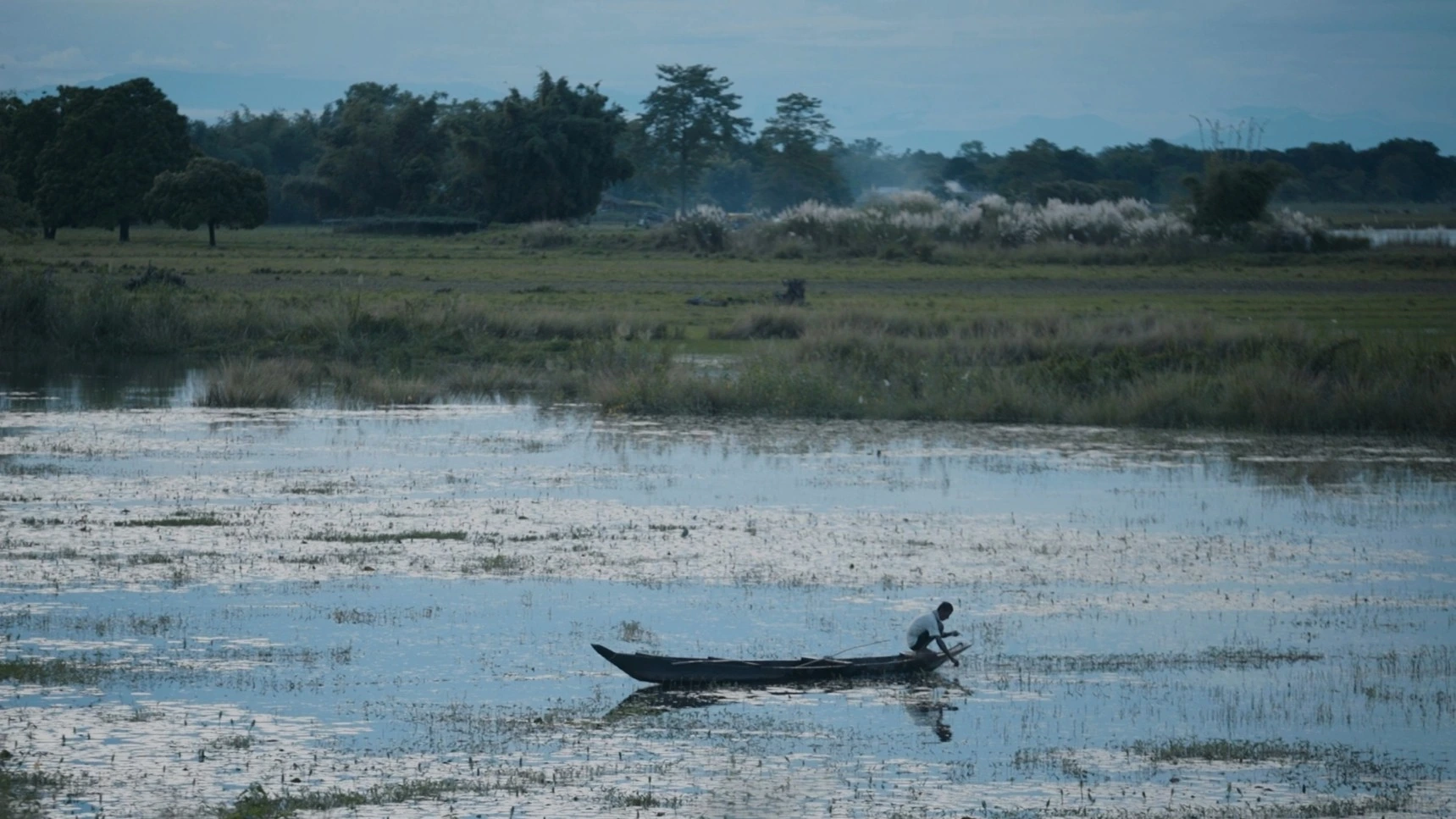
The Misings, who are spread across areas close to the Kaziranga National Park and Tiger Reserve, have recently faced unique threats to their lifestyle. Climate change and infrastructural interventions have reduced the availability of fish; the community worries about the future. Undoubtedly, these changes have impacted the production of Namsing as well. “The floods are not the same. We need the floods to clear out all the debris and bring in the fish hatchlings, but lately extreme floods followed by drought-like conditions and erratic weather have impacted humans and animals in Kaziranga,” says 30-year-old Pegu. Alongside his work as a guide, the Kardongs’ grandnephew is a member of the Greater Kaziranga Land and Human Rights Committee.
To contain the devastating impacts of the floods, large embankments are being built. Despite such measures, these regions are considered to be some of the most precarious places in Assam, a state which is among the most vulnerable in India as it reels from the impacts of an altered climate. Engineering interventions like large embankments have blocked out much of the water bodies which are connected to the Brahmaputra river system, while growing industrial activities in surrounding towns have polluted the rivers—even the ones flowing inside the National Park.
During lean months when the fish catch reduces, Namsing becomes the cheapest protein source for the Mising families.
The Kaziranga Park, declared a world heritage site by UNESCO, follows a militarised conservation model which prevents locals from collecting traditional herbs and fish from inside its boundaries. “We are not allowed inside the park, but it is us who conserve Kaziranga by feeding the animals that stray outside during various calamities. We clear the water bodies of hyacinth, providing breathing space for the fish,” says Numal as he opens a two-year-old tube of Namsing.
Muguri and the women from neighbouring homes are preparing a feast. A small portion of Namsing, coupled with pieces of meat, are served along with Apong, a local rice brew. The chillies in the Namsing have added a bright, spicy edge, but the fermented fish paste still has a sweetness attached to its pungency. The meram is bathed in the aroma of yet another batch of Namsing as everyone savours the strong, heady flavours.
Edited by Anushka Mukherjee and Neerja Deodhar
Also read: For Odisha’s Chuktia Bhunjias, preservation by drying is tradition—and sustenance
{{quiz}}
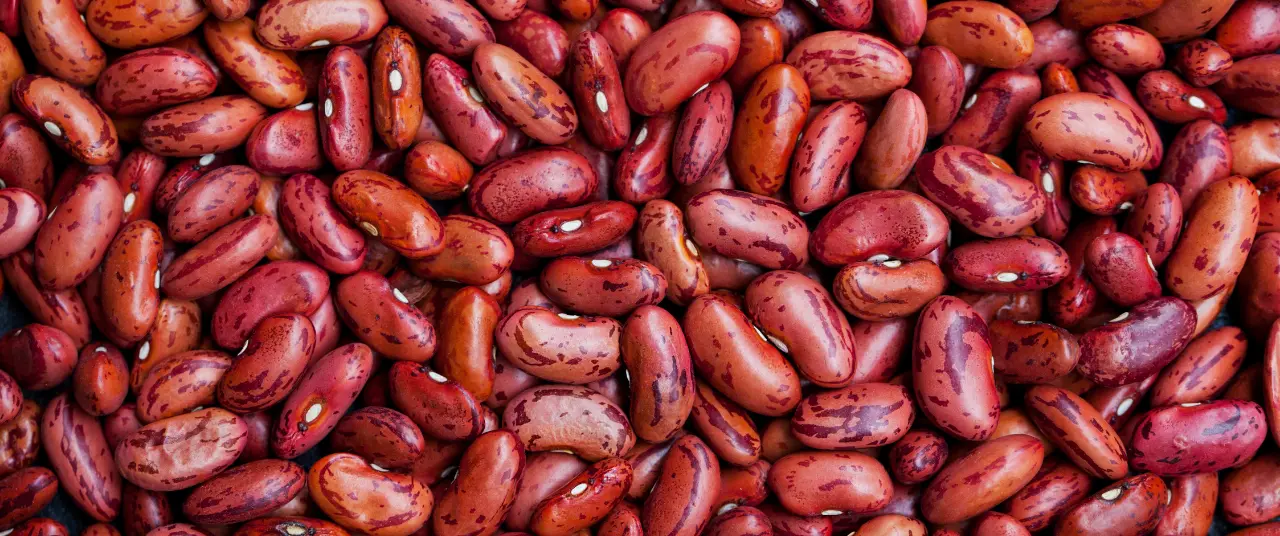
While isolates offer concentrated, easily absorbable protein, whole foods deliver it alongside a diverse set of nutrients
Editor's Note: From grocery lists, to fitness priorities, and even healthy snacking, protein is everywhere—but do we truly understand it? In this series, the Good Food Movement breaks down the science behind this vital macronutrient and its value to the human body.
Protein is a trendy, marketing currency in today’s nutrition landscape, added to snacks, drinks, bars, cereals, and even desserts. Much of this protein content comes from isolated protein ingredients like whey, soy or pea protein.
Trendy snacking aside, most Indians actually continue to get their protein from whole foods like dals, pulses, eggs, milk, nuts, meat, and grains. Both these categories make for beneficial sources, but they are not the same. The body processes them in very different ways, influencing digestion, nutrient delivery and overall health.
Whole-food protein refers to protein which is part of the natural, intact structure of a natural, whole food—also known as the food matrix. In milk, for instance, protein co-exists with natural fats, lactose, minerals, and enzymes. In dals, protein is surrounded by fibre, resistant starch and phytochemicals (naturally occurring plant compounds, which lend them their colour, scent, and flavour). In eggs, protein is embedded within a natural balance of fats, micronutrients, and water.
Studies on the ‘food matrix effect’ consistently show that this structure influences protein digestibility, how long you stay full, and the absorption of other nutrients. Because whole foods carry multiple nutrients, they also deliver iron, zinc, calcium, B vitamins, phytonutrients and healthy fats together with protein—supporting metabolism beyond muscle repair.

Also read: The science behind bodily protein: What are complete and incomplete sources?
Protein isolates, by contrast, are highly processed ingredients created by extracting and purifying protein from a whole food, and then consumed as an isolated nutrient. Through filtration, precipitation, and other biochemical treatments, most fats, carbs, fibre, and moisture are removed. What remains is either a concentrated protein (containing about 70% protein) or a stronger protein isolate (containing about 90% protein). Whey isolate, soy isolate, pea isolate and rice isolate are some of the most common forms used in packaged ‘high-protein’ foods.
Because whole foods carry multiple nutrients, they also deliver iron, zinc, calcium, B vitamins, phytonutrients and healthy fats together with protein—supporting metabolism beyond muscle repair.
Because isolates are stripped of the food matrix, they digest quickly and raise blood amino acid levels much faster than whole foods like milk, yoghurt, or pulses. This rapid absorption is well-documented in sports nutrition research, especially for whey. Isolates, therefore, serve a different purpose: they provide high-density, fast-acting protein in small volumes, which can be helpful for athletes, older adults with low appetites or people with specific clinical needs.
Also read: Is there an ‘ideal’ amount of protein that must be consumed?
The key scientific distinction is how the body encounters these two categories of proteins. Whole foods, because of their intact matrix, release amino acids gradually. Fibre slows the emptying of the stomach, which means that nutrients reach and are absorbed in the small intestine in a staggered manner, leading to slower glucose spikes and longer satiety. Natural fats moderate digestion, and the physical structure of the food requires more breakdown. This is why the protein in dals or millets takes longer to digest, and why milk delivers a steady trickle of amino acids, thanks to its natural blend of slow-digesting casein and fast-digesting whey protein.
Isolates, therefore, serve a different purpose: they provide high-density, fast-acting protein in small volumes.
Protein isolates behave differently. Without fibre or fat to slow them down, they pass through the stomach more quickly and cause a sharp rise in circulating amino acids. This can be useful in situations where rapid availability is beneficial, but does not replicate the long, steady absorption pattern of whole foods.
Whole-food proteins involve minimal processing: soaking, fermenting, cooking or boiling. Isolates are the product of extensive industrial processing that removes everything except protein. This does not make them unsafe, but it does make them nutritionally narrower. Emerging research on ultra-processed foods suggests that foods built primarily from isolated ingredients may influence satiety, digestion and long-term eating patterns differently than whole foods, even when they contain comparable macronutrients.
Neither category is inherently superior, they simply serve different functions.
Neither category is inherently superior, they simply serve different functions. Whole foods provide protein within a nutrient-rich package that supports broader metabolic outcomes—satiety, digestion, and overall dietary balance. This is why organisations like the ICMR, FAO, and WHO recommend meeting protein requirements primarily from whole foods. On the other hand, isolates offer precision and efficiency. They allow people to add large amounts of protein without adding much fibre, fat, or calories.
For those with high daily requirements, limited appetite, or time-restricted diets, isolates can be a useful supplement. But they contribute little beyond protein itself, and relying on them heavily may compromise diet diversification. For most people, whole-food protein should form the foundation of the diet, with isolates used selectively to bridge gaps rather than define the meal.
Also read: More isn’t always better: Are you overdosing on protein?
{{quiz}}

Legumes form the bulk of cover crops, but Brassicas and oilseeds play important roles in replenishing soil
Editor's note: Even before its current status as a nutrient-rich superfood, ragi has been a crucial chapter in the history of Indian agriculture. Finger millet, as it is commonly known, has been a true friend of the farmer and consumer thanks to its climate resilience and ability to miraculously grow in unfavourable conditions. As we look towards an uncertain, possibly food-insecure future, the importance of ragi as a reliable crop cannot be understated. In this series, the Good Food Movement explains why the millet deserves space on our farms and dinner plates. Alongside an ongoing video documentation of what it takes to grow ragi, this series will delve into the related concerns of intercropping, cover crops and how ragi fares compared to other grains.
In the 2 acres of land in Tiptur where the Good Food Movement is growing ragi, we used six cover crops: sunn hemp, spiny sesbania, horsegram, cowpea, mustard, and sesame. Together, these six crops replenished soil by fixing atmospheric nitrogen, adding soil organic carbon, and serving as biological pest control. Though their name points to their function of 'covering' the land, they serve several other important roles, too. But how does one find out which cover crops to sow and if they are suited to the landscape’s cropping conditions?
Cover cropping has always been part of traditional farming, and is now being brought back into mainstream agricultural practice by proponents of organic farming. Cover crops are a natural alternative to chemical fertilisers, steadily replenishing soil nutrients, increasing microbial activity, and aerating it without negatively impacting life underground, or water quality. A 2021 report by the Council on Energy, Environment and Water (CEEW) estimates that around 1-2 million farmers in India practise cover cropping.
Cover crops can be broadly categorised as legumes and non-legumes. The legumes’ main function is nitrogen fixation. Legumes form symbiotic relationships with the rhizobium bacteria and fix atmospheric nitrogen into the plant’s root nodules, enabling plants to utilise what would otherwise be inaccessible. Upon decomposition, this nitrogen finds its way back to the soil, which is further used by succeeding crops and microbes. Over 80% of GFM’s chosen cover crops (sunn hemp, spiny sesbania, horsegram, cowpea) are legumes. Cowpea, additionally also forms a symbiotic relationship with certain phosphorus-fixing fungi, thus enhancing the soil’s access to another major macronutrient.
Legumes form symbiotic relationships with the rhizobium bacteria and fix atmospheric nitrogen into the plant’s root nodules, enabling plants to utilise what would otherwise be inaccessible.
The remaining 20% of cover crops are usually non-legumes. GFM used two oilseeds, sesame and mustard, the latter belonging to the Brassica genus. Most legumes have more nitrogen than carbon and decompose quickly. Non-legumes have a higher carbon to nitrogen ratio; this slows down decomposition because carbon is harder for soil microbes to break down. This staggers nutrient release and contributes more to soil organic matter. These are also crops that grow aggressively and leave a lot of residue—thus suppressing any competing weeds and preventing soil erosion.
Also read: Why Akkadi Salu, an ancient practice of intercropping ragi, deserves a comeback
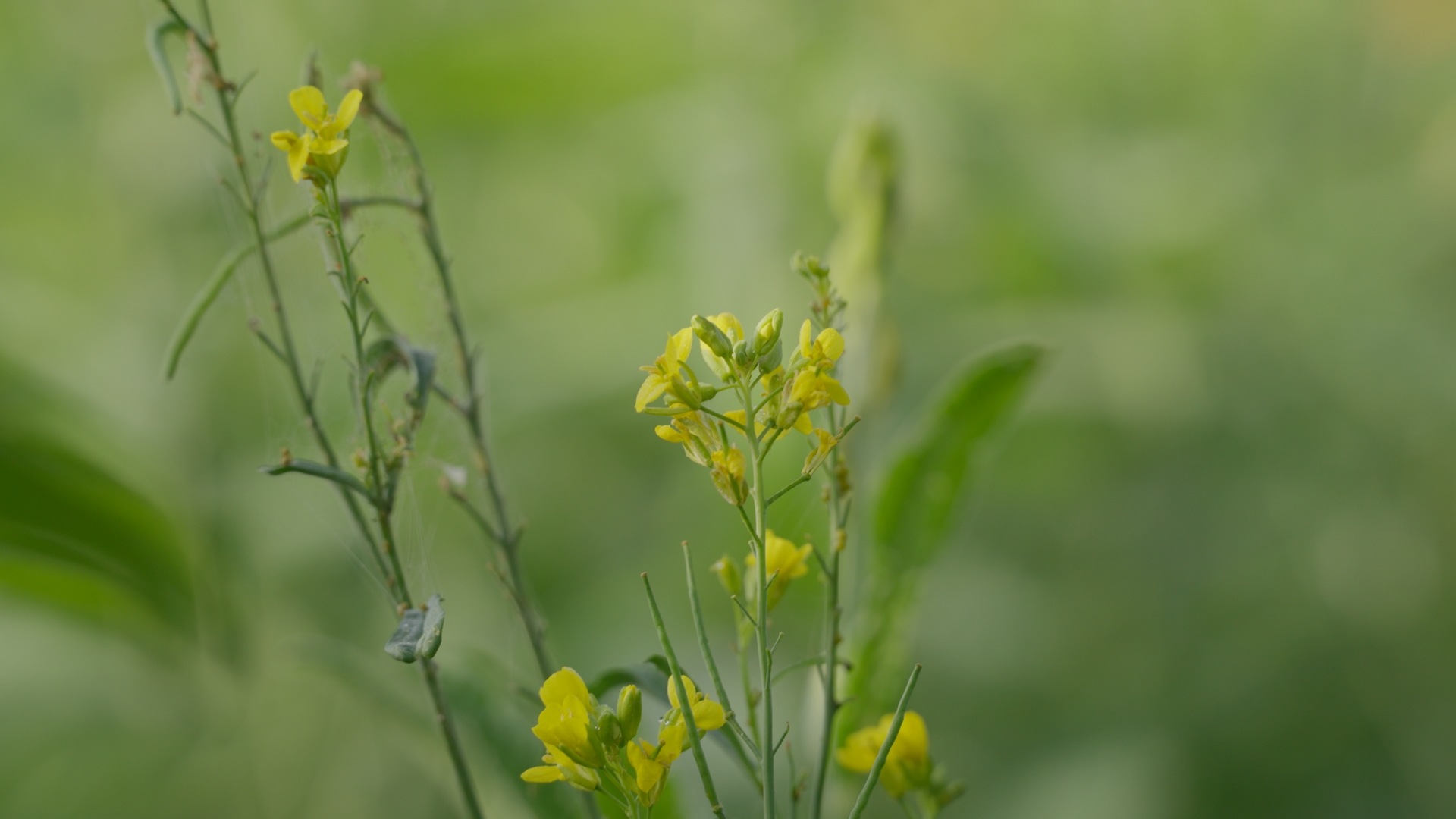
Cover crops of the Brassica genus have an additional benefit: they are biofumigants. Plants like mustard, radish, and cauliflower have the ability to release certain biocidal compounds that are toxic to various soil-borne pests, pathogens, and weeds. This makes them a natural alternative to chemical pesticides.
Different plants have different ways of interacting with the soil and getting nourishment. Cover crops are a way to bring balance to the kind of crops being sown. To understand this, it’s helpful to look at the fundamental division within flowering plants: monocotyledons (monocots) and dicotyledons (dicots). The seed’s embryo contains cotyledons, or leaves of the seed. Whether there is one leaf (monocot) or two leaves (dicot) influences visible physical characteristics like roots, stems, and leaves. But it also influences plant functioning—how it photosynthesises, stores nutrients, and reproduces. This information becomes crucial for farmers and botanists to understand and predict plant behaviour.
Roots also strengthen soil structure by aggregating soil particles better; having roots at different strata serves to strengthen and nourish both the soil and plant better.
One such major difference between monocots and dicots is in their root patterns. Monocots (generally cereals like rice, wheat and ragi) have fibrous roots that spread wide horizontally, rather than vertically. Dicots (legumes and fruit crops) have tap roots that go deep into the soil for nutrients. Being of different lengths, dicot and monocot roots get nutrients from different strata of the soil and subsequently decompose to return organic matter to that strata. Roots also strengthen soil structure by aggregating soil particles better; having roots at different strata serves to strengthen and nourish both the soil and plant better.
They also become a way of nutrient cycling, i.e. bringing nutrients deeper in the soil to the surface. A great example here is mustard. While mustard doesn’t fix atmospheric nitrogen like a legume, it is a nitrogen lifter: it scavenges residual nitrogen from deeper layers of the soil and makes it available to the subsequent crop.
Also read: How cover crops sync with nature to replenish soil without chemical fertilisers
The world’s current cropping patterns lean towards more cereals, i.e. more monocots, because they are major carbohydrate sources. To make up for that, most cover crops are dicots. Ragi, GFM’s main crop in this farming experiment, is a monocot, and so all our cover crops are dicots.
The specific whittling down of which cover crops should be sown depends on the climate and the type of soil characterising the region. It is a good idea to observe what other farmers in that region have traditionally planted to understand what crops will be suited to it. For example, spiny sesbania [dhaincha] is commonly used in Karnataka as fodder, and mustard and sesame have culinary significance in the region.
The world’s current cropping patterns lean towards more cereals, i.e. more monocots, because they are major carbohydrate sources. To make up for that, most cover crops are dicots.
Once these cover crops are chosen, they are mixed together with approximately 30 kg worth of seeds per acre. They are then hand broadcasted, as per the traditional intercropping practice Akkadi Salu. From there grows a diverse crop, to create a diverse soil ecology.
{{quiz}}
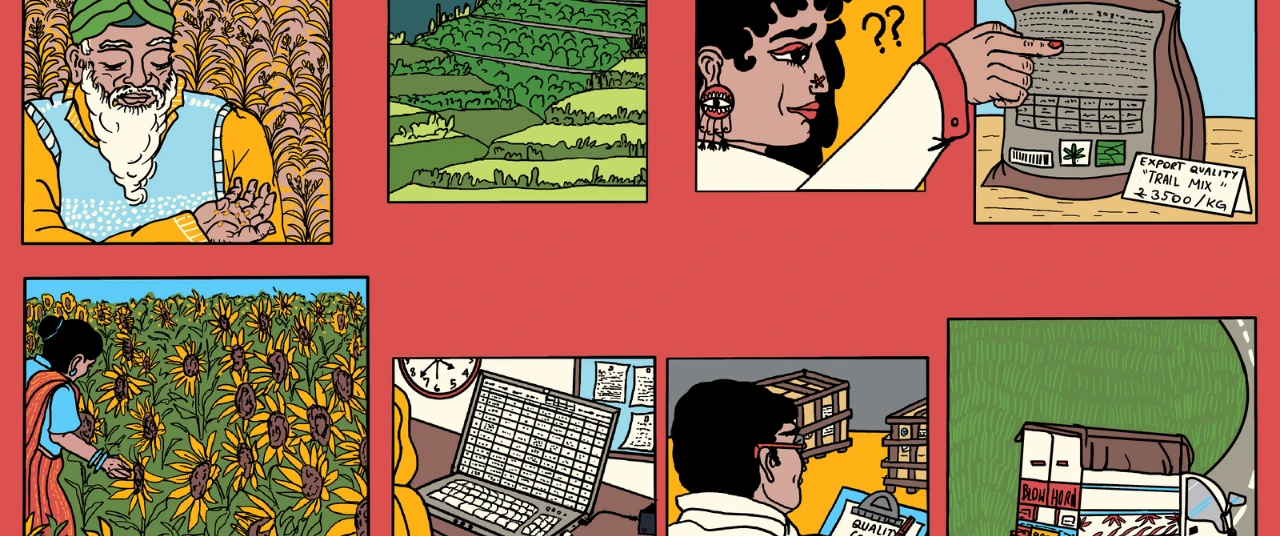
The solution lies not just in tightening rules, but also reducing the cost of compliance
The Plate and the Planet is a monthly column by Dr. Madhura Rao, a food systems researcher and science communicator, exploring the connection between the food on our plates and the future of our planet.
As consumers, do we have the right to know more about where our food comes from? With food borne illnesses and lifestyle disease statistics making headlines frequently, this is a fair question, but also one that is difficult to answer. Modern supply chains are vast, and even seemingly single-ingredient foods often come from multiple sources. Tea may be blended from several estates, coffee from different regions and honey from hundreds of small apiaries. For foods with many ingredients, tracing each component is even more challenging.
For consumers, this information is not always useful. What most people need is reassurance that the food they buy is safe and stands up to the various claims made on its packaging. For businesses and public authorities, however, knowing where each ingredient comes from is essential. When contamination or adulteration occurs, they must be able to identify where the problem began and act quickly to remove affected products. A reliable traceability system is therefore less about telling consumers every detail of origin, and more about ensuring that producers and regulators can track the chain of responsibility when needed.
In the past, supply chains were short and local, allowing producers and consumers to maintain direct relationships built on trust. Industrialisation and the consequent globalisation of food trade weakened those connections. As food began to move across states and countries, it became necessary to create systems that could record where a product came from, how it was handled, and where it was going next.
The modern understanding of traceability developed between the mid to late twentieth century when several food crises exposed weaknesses in existing systems. Globally significant events such as the outbreak of the mad cow disease in Europe in the 1980s and the adulteration of Chinese infant formula with melamine in 2008 had far reaching public health consequences, pushing countries to recognise traceability as essential to public health. In the 1960s, the Codex Alimentarius Commission, a joint body of the Food and Agriculture Organization (FAO) and the World Health Organization (WHO), set international standards for food safety and fair trade. It defines traceability as ‘the ability to follow the movement of a food through specified stage(s) of production, processing and distribution’. The Commission regularly revises its guidelines to reflect new scientific developments, and its framework serves as the foundation for most public and private traceability systems worldwide. Today, traceability in food supply chains has moved from paper records to digital systems that use barcodes, Radio Frequency Identification (RFID) technology and even blockchain, making it possible to trace the source of even the most minute ingredients in products that have travelled halfway across the world.

Also read: A new science-backed Planetary Health Diet is in the spotlight. How does the Indian diet measure up?
Indian agriculture is dominated by rural smallholders. A single supply chain can include hundreds of farmers cultivating small and scattered plots of land. Many have limited access to smartphones, stable internet or digital literacy tools. Similarly, processing activities are undertaken by lakhs of small and medium sized factories around the country. Transactions are still recorded on paper, and even when they are digitised, they are often not managed effectively. Tracing the source of an ingredient can therefore mean searching through paper ledgers or incomplete digital files instead of accessing a well-maintained database.
Export markets, where transparency is rewarded through price premiums and market access, make such investment worthwhile. In contrast, domestic buyers rarely pay more for traceable produce, so food businesses have little incentive to adopt these systems.
Developing robust traceability systems is also expensive. Setting up the digital infrastructure, organising audits, obtaining certifications, and training quality assurance and administrative personnel requires continuous investment. For small producers operating on narrow margins, these costs are difficult to bear unless traceability leads to higher returns. Export markets, where transparency is rewarded through price premiums and market access, make such investment worthwhile. In contrast, domestic buyers rarely pay more for traceable produce, so food businesses have little incentive to adopt these systems. As a result, export-oriented supply chains in India have developed strong traceability systems, while those serving domestic markets often rely on fragile documentation practices and informal networks of trust among the many actors involved.
The Food Safety and Standards Act of 2006 provides the legal basis for food control in the country, while the Food Recall Procedure Regulations of 2017 require manufacturers to withdraw unsafe food and communicate with consumers when necessary. In 2022, a survey of 30 food businesses in Delhi and the National Capital Region revealed how limited domestic traceability remains. Nearly all participants used barcodes to display retail prices, but only a small fraction maintained recall or traceability protocols. Many companies were unaware of how to trace products backward to their source or forward to distributors in case of a safety issue. This suggests that the tools of traceability exist but are used primarily for labelling and pricing, not for safety or accountability.
Sustainability certifications rely on detailed records that show where ingredients come from, how they were grown, and which standards were followed at each stage of production. Without this chain of evidence, sustainability labels would have little meaning.
Milk, for instance, is a product where quality lapses continue to be reported. Raw milk often moves through a chain of village collectors, chilling centres, transporters, and small dairies before it reaches consumers, and problems can arise at several points along this route. Periodic surveys by public authorities and independent researchers have found both dilution and the use of substances such as detergent in different regions. Paneer faces comparable challenges. Alongside batches made from low quality milk, there is a growing market for analogue paneer made with processed vegetable fats and other non-dairy ingredients. This can amount to food fraud when such products are sold as paneer without clear disclosure, leaving consumers unsure of what they are actually purchasing. Much of this activity takes place in small, informal units with limited records, so when adulteration or mislabelling is detected, authorities often struggle to identify the specific source and must issue broad advisories instead of targeted action.
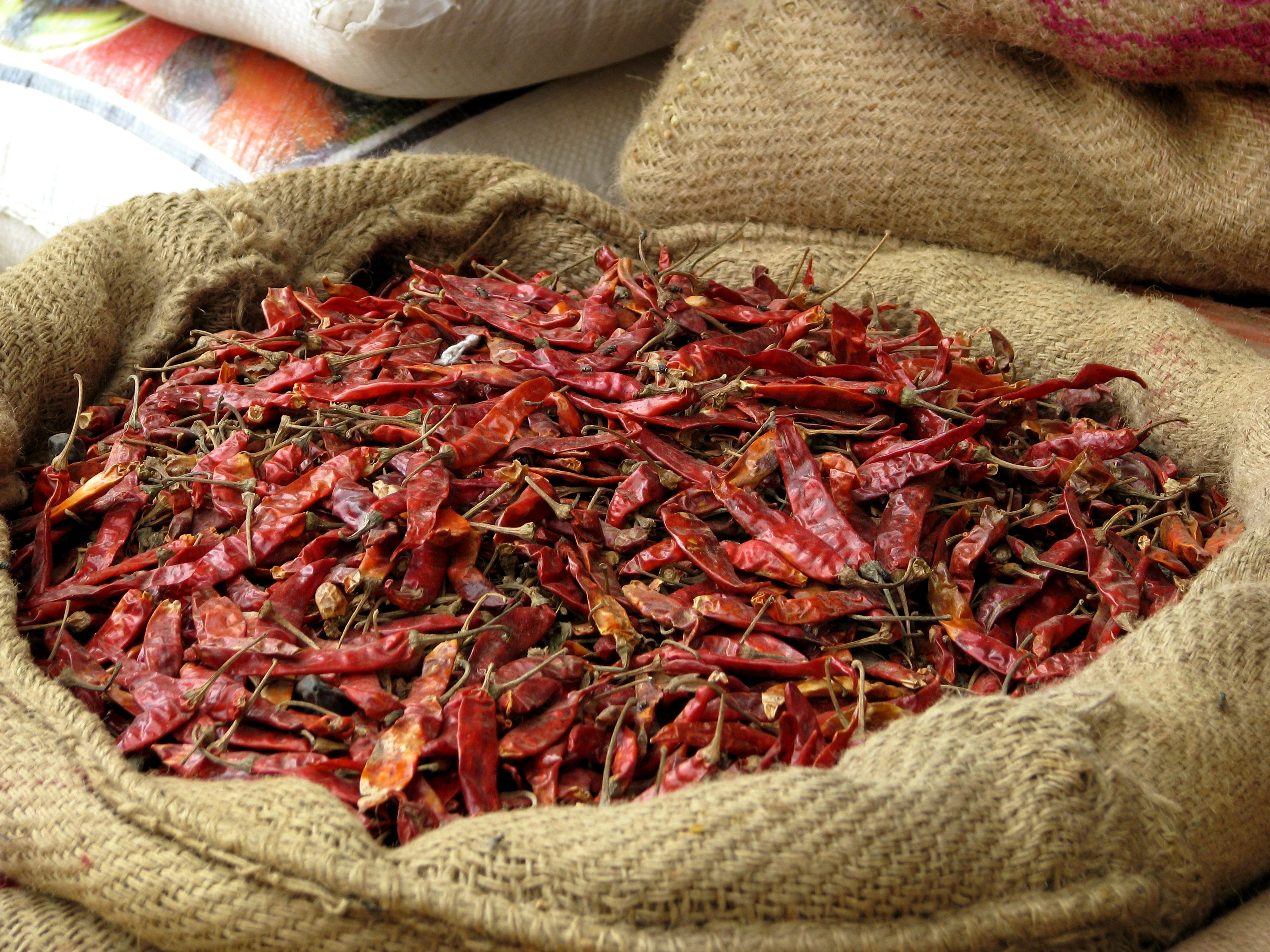
The weaknesses in domestic traceability have contributed directly to recurring cases of contamination, adulteration and foodborne illness. The FSSAI frequently issues alerts and recalls, and one of the most prominent recent examples involved packed spice blends, which came under scrutiny both abroad and at home in 2024, after multiple countries detected the carcinogenic pesticide ethylene oxide in popular brands. Weak traceability systems mean that investigations must rely on manual records, supplier declarations, and blanket bans leading to financial losses for businesses and an erosion of trust among consumers.
Traceability today goes beyond food safety and has become an important tool for ensuring environmental and social sustainability as well. Sustainability certifications rely on detailed records that show where ingredients come from, how they were grown, and which standards were followed at each stage of production. Without this chain of evidence, sustainability labels would have little meaning. An organic label is based on proof regarding a production system being free from synthetic fertilisers, pesticides and genetically modified inputs. Fair trade certification verifies that farmers receive fair prices and work under safe conditions. Other claims, such as ‘rainforest certified’ or ‘shade-grown’, are linked to biodiversity protection, while ‘cage-free’ and ‘free-range’ labels concern animal welfare.
Sustainability certifications such as these are often treated as add-ons that signal higher ethical or environmental value and therefore command a price premium in the market. In the Indian context, as with food safety, such traceability systems are found mostly in export-oriented sectors. Products sold domestically seldom undergo the same level of verification, and sustainability claims remain limited to a small, urban consumer base that can afford to pay more for them.

Setting up traceability systems is an expensive affair, and it is usually large manufacturers, supermarket chains, and export-oriented companies that have the resources to build and maintain them. For smaller suppliers and local retailers, the same requirements are far more difficult to meet. When only large companies can afford to meet compliance requirements, supply chains begin to be increasingly controlled by them. To ensure that every product can be traced, these firms often bring more of the production process under their direct control, a strategy known as vertical integration. In a vertically integrated supply chain, a company owns or manages several stages of production, such as farming, processing, packaging, and distribution. This can make traceability easier, but it also concentrates decision-making power, leaving less room for small and independent actors.
Instead of simply tightening rules, regulators can focus on reducing the cost of compliance.
Public supervision can help avoid this outcome. Regular inspections and transparent monitoring by government authorities can make traceability a shared responsibility rather than a private asset. Instead of simply tightening rules, regulators can focus on reducing the cost of compliance. Affordable digital tools, publicly funded data storage platforms and simplified reporting formats would allow small and informal businesses to meet basic traceability standards without being forced out of the market. This is especially important in India, where about 1.2 crore kirana stores account for more than 90% of sales in the Rs 67 lakh crore ($810 billion) food and grocery market. These small businesses are central to the economy and to the daily lives of ordinary consumers, which makes it essential that systems of safety and accountability are designed to include them. Additionally, penalties for deliberate fraud and mislabelling remain necessary not only to deter malpractice, but to protect public health—and ensure that honest and compliant businesses can compete fairly, without being undercut by those who cut corners.
Also read: Ultra-processed foods are reshaping our diets. Should we be worried?
Artwork by Alia Sinha
{{quiz}}

Falling appetite and hormone changes make it harder to eat healthy and retain mobility
Editor's Note: From grocery lists, to fitness priorities, and even healthy snacking, protein is everywhere—but do we truly understand it? In this series, the Good Food Movement breaks down the science behind this vital macronutrient and its value to the human body.
What does it mean to age? Is it just the wrinkles, strands of grey hair, and constant back pain? These are just glimpses of the larger slowing down of the grand, complex machine that is the human body. Behind the scenes, cells grow old and tired, and the body is not able to send newer cells to relieve them. Organs that have served the body for decades take longer and need more support to execute the same functions. The body retains adequate functionality to keep us afloat, but stressors like injuries or disorders can rock the boat uncomfortably.
It can feel very helpless and frightening to watch a strong body falter like this. Some of that helplessness is reasonable, but your diet and physical exercise levels influence how deeply this wear and tear impacts your body. India's elderly population (aged 60 and above) has increased four-fold over the past 50 years. In 2019, of the estimated 136.6 crore population of India, the number of aged population (>65 years) was 8.7 crores, and by 2050, it is expected to reach 22.5 crores. This makes it crucial that we understand nutrition for the elderly.
As you age, your body is dealing with two problems at once: you are struggling to absorb nutrients the way you used to, and your body needs them more desperately than before. Why exactly does ageing make it harder to access nutrition?
Firstly, your body's systems to pick up on hunger signals get disrupted. Biological factors like reduced production of hormones and slowing stomach digestion make up one part of this. Additionally, vision, smell, and taste slowly start deteriorating sometime in mid-life (between 40 and 60 years of age). Though not directly related to digestion, these three senses are core to how we experience food. Without them, how can one look forward to mealtime? The very act of eating becomes bereft of joy, and caloric intake falls. Common dental issues like decreased saliva production, difficulty in chewing, and loss of teeth can further interfere with how appetising meals are. At the same time, you are exercising lesser, and your resting metabolic rate (basic energy expenditure for keeping organs functional) is falling—thus reducing your caloric needs. Energy levels fall too, and people have little motivation to spend it on preparing food. Together, this makes it hard for older folks to eat well.
While their appetite suffers, so does the absorption of nutrients. Stomach acid levels fall, digestive enzyme production slows, the composition of the gut microbiome changes which specifically make it harder to absorb vitamins, minerals, and proteins. Intestinal motility, or the intestine’s ability to contract and dilate, also weakens with age, and slows down the transport of digested nutrients. Decreased functioning of the proteins that are responsible for amino acid transportation decreases the efficiency with which the body is able to absorb it. Older people also run a higher risk of developing gastrointestinal disorders that affect digestive processes and bioavailability of nutrients.
Also read: The science behind bodily protein: What are complete and incomplete sources?
For women, age also marks an important shift: menopause. Almost an entire life of periods can predispose anyone to celebrate their end, but menopause brings its own troubles. Throughout menopause, which usually starts in the 40s and can last for up to a decade, estrogen levels fluctuate until they fall and plateau. Estrogen regulates not just the menstrual cycle, but also appetite. The sudden reduction in the production of estrogen, as happens during menopause, is associated with an increase in abdominal fat. It also speeds up the loss of bone density in women. These losses come from a higher rate of breakdown compared to synthesis in muscles. Protein is crucial to reducing the imbalance between the two, and reducing the net breakdown of muscle and bone mineral mass. In these ways, protein is all the more crucial for women as they enter menopause.
Also read: Protein traceability: Why knowing where your milk and pulses come from matters
The fundamental rules of good nutrition stay the same with the elderly—but reduced appetite makes it harder to ensure they get it, and the results of a deficiency have greater ramifications.
Older folks are especially prone to developing a protein deficiency. Not only is digestion and absorption affected, difficulty in chewing and swallowing also restrict access to rich sources of complete protein like meats. They are also less responsive to anabolic (muscle synthesis) stimuli when the amino acid levels are low, i.e. they need a larger dose of protein to get the same results as younger adults.
How this increased need is expressed changes. Some express it as a Recommended Daily Allowance (RDA) of 1.2-2g per kg of body weight. However, the RDA was calculated by a methodology that estimated how much protein is required to ensure the body does not lose nitrogen, rather than through a focus on how protein is impacting bodily strength and functions. In its place, protein intake can be measured in terms of the Acceptable Macronutrient Distribution Range (AMDR). AMDR expresses nutrient intake as a percentage of total energy intake, and recommends 10-35% of the total energy for protein. AMDR is especially useful while discussing the nutrient needs of older adults, because their total caloric intake falls with age, and focusing on a percentage can help ensure that an adequate proportion of their diet is including protein. At the same time, it is advised that around 55% of caloric intake be carbohydrates to prevent the body from breaking down protein for energy.
One of the major impacts of a protein deficiency is an acceleration of age-related muscle mass loss (sarcopenia) and bone density loss (osteopenia). It leads to a drop in strength and functionality, and has a direct relation to loss of independence and mobility among elderly adults. It is also associated with frailty, an increased risk of injury, and longer recovery times.
Adequate protein is thus central to retaining functionality as we age, and to work best, it must be paired with exercise. Studies have shown that even five days of bed rest reduces muscle protein synthesis in the elderly—a worrying sign of what an injury or hospital visit can mean for muscle breakdown. In contrast, any form of physical activity has benefits, and can help reverse mobility functions that have been lost. High-intensity strength training is recommended for those prone to muscle loss and frailty.
Regular exercise and a balanced diet become all the more important with age because the body’s failing systems make it harder, both physically and emotionally, to take care of ourselves. Moreover, the body’s disposition to lose muscle mass and to get injured make protein a crucial nutrient to ensure strength and recovery. Ensuring that an elderly adult gets the protein they need involves some planning, but with it comes a satisfying reward: true independence, well into old age.
Also read: The ‘right time’ to eat protein: Little and often, rather than in one meal
{{quiz}}

A series of floods and landslides has raised questions about strategies to survive climate disasters
In the Tholang village of Himachal Pradesh’s remote tribal district of Lahaul and Spiti, Sahm Azad, a 45-year-old farmer, stands beside what remains of his cabbage and iceberg lettuce fields. Over August and September, he grappled with devastating losses after heavy rainfall, cloudbursts, and landslides that battered the region this monsoon.
Azad, who owns less than three acres of land and depends entirely on a single crop cycle between April and October, says his annual income—around Rs. 4 to Rs. 5 lakh—has vanished overnight. “Almost everything we grew has been destroyed. What little survived couldn’t even leave the valley because the roads were gone,” he says. “We usually cover our yearly expenses with one crop, but this time, we’re worried about how we’ll feed our families.”
Lahaul-Spiti, which remains buried under snow for nearly six months each year, is known for its short but lucrative growing season. During summer, farmers cultivate high-value vegetables—peas, potatoes, cabbage, broccoli, lettuce, and other exotic varieties—that are sent to wholesale markets in Delhi and Chandigarh, and supplied to five-star hotels across northern India. The exotic vegetables, in particular, enjoy an “unlimited market;” for the cool temperatures of May to October in the hills give them an advantage over the warm plains, which offer no competition.
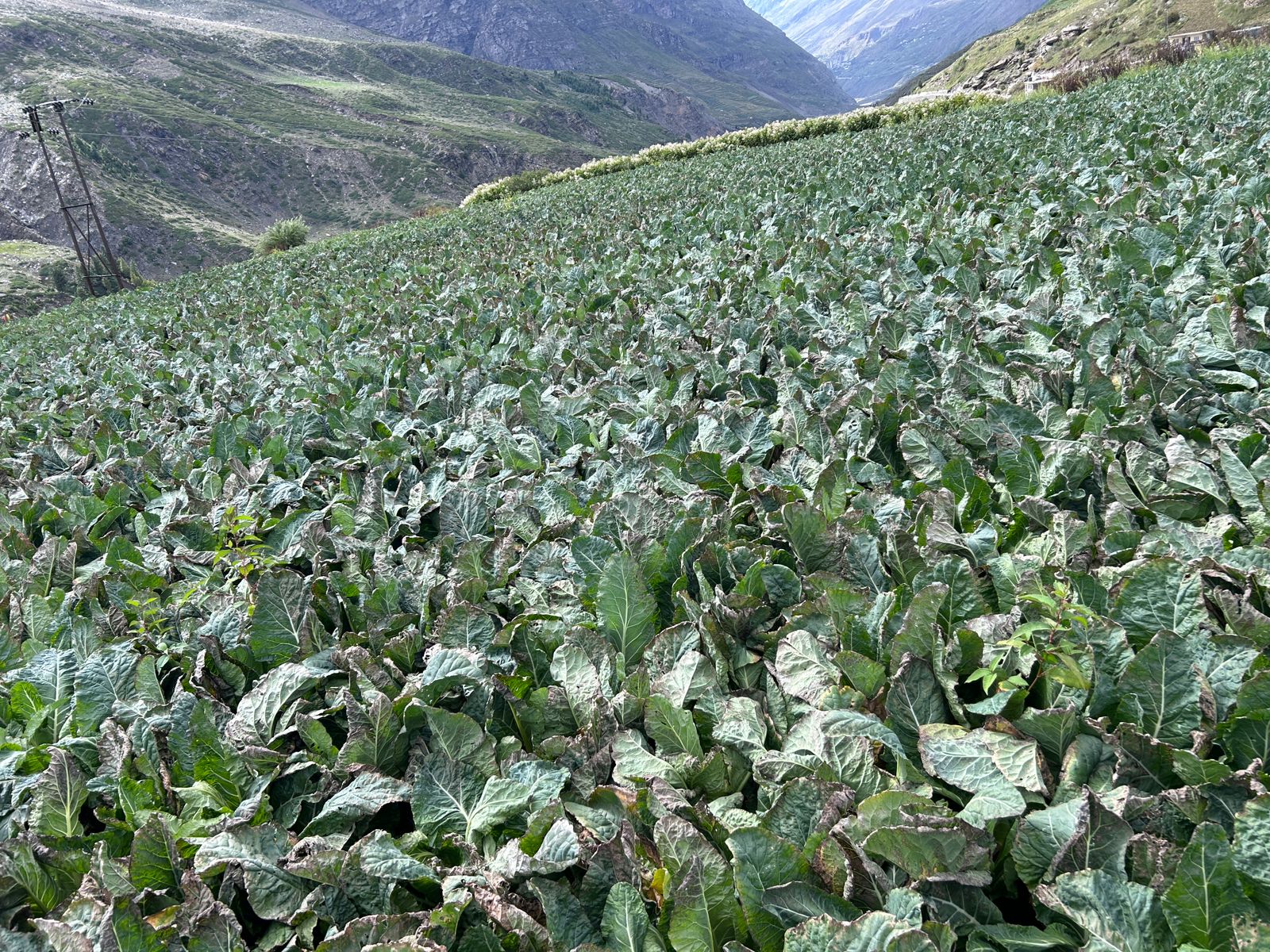
As a result, over the last decade, a growing number of cultivators in the state have switched over from cereals to exotic vegetables and horticulture. For thousands of farmers and labourers, these crops are the backbone of their livelihoods.
This year, however, that backbone has been shattered. Between August 22 and 27, heavy rains triggered landslides that cut off major highways and isolated entire valleys, severely damaging stretches of the Chandigarh–Manali four-lane and the Manali–Leh highway. For nearly three weeks, Lahaul-Spiti remained inaccessible to the rest of the state.
With access blocked until early September, vegetables ready for harvest could not reach the markets. Entire truckloads of produce—harvested after months of labour—rotted in the fields.
For nearly three weeks, Lahaul-Spiti remained inaccessible to the rest of the state.
Now, the next crop cycle, too, is at risk. Heavy rains and landslides have damaged agricultural irrigation systems across the valley. Farming in Lahaul relies primarily on “kuhls,” small traditional canals that divert glacial water to the fields. Many of these have been washed away or broken. “The irrigation of our fields depends entirely on these canals,” Azad says. “If they are not repaired soon, sowing after April next year will be affected. Once snowfall begins, repair work will become impossible.”
“All our hard work has been wasted,” says Motilal, a 52-year-old farmer from Madgran village in Udaipur. “This isn’t the first time weather has ruined our crops, but the scale of the damage in the last few weeks has been enormous. Farmers across villages are drowning in debt, and confidence in farming is fading fast.”
According to data from the Lahaul-Spiti Agriculture Department, cabbage crops have suffered the worst. Roughly 1,842 metric tonnes of cabbage, valued at Rs. 18 crore, were damaged across 5,758 acres of the district. By August alone, the horticulture sector in the state had already suffered a loss to the tune Rs 2,743 lakh, and the agriculture sector had taken a hit of approximately Rs 1,145 lakh.
Sam Bodh, a young farmer in Lahaul Valley, says he produced about 30,000 kilos of cabbage this year, but only half made it to the market. “Almost every family I know here has lost Rs. 4–5 lakh this time,” he says. “Paying back loans or even labourers’ wages has become a struggle.”

The impact extended beyond local farmers to the hundreds of Nepali labourers who cultivate leased land in Lahaul. Thaman Kumar, who has farmed in the valley for a decade, says this is the first time he’s returning home empty-handed. “Usually, by this time I’ve already sent money to my family for school fees,” he says. “Now I don’t even have enough to clear the loans we took for seeds and transport.”
In addition to vegetables, the apple crop has also been severely affected in the state. Himachal produces up to 4 crore apple boxes annually, with a turnover of Rs. 4000-5000 crore. However, this year, rain and landslides destroyed roads in apple-producing districts like Shimla, Kullu, Mandi, and Kinnaur. In areas like Banjar and Lag Valley in Kullu, apple crops were unable to reach the markets, forcing farmers to abandon their produce. The preliminary estimates reveal losses of up to Rs. 1000 crore for apple farmers in the state.
Also read: Omega-3 fatty acids: The hidden cost of 'health' to our seas
The ripple effects of the monsoon choked the entire supply chain that moves vegetables from Lahaul’s cold desert to the mandis of northern India. Farmers in the region sow in March and harvest begins in early July. Normally, intermediaries called adhtiyas collect vegetables from field-side points and sell them across Himachal and beyond from July to October. This year, however, adverse weather and road closures blocked the Manali–Leh and Chandigarh–Manali highways, forcing drivers to take long, difficult alternative routes and preventing adhtiyas from reaching the valley.
.jpeg)
“Earlier, we could reach Amritsar Mandi from Lahaul overnight,” says Vikas, a pickup driver who ferries vegetables for local traders. “This time, it took us three days. We had to go via Kaza and Shimla, almost doubling the distance—from about 480 to 970 kms. The fare went up from Rs. 16,000 to Rs. 28,000. The roads were so bad we had to repack the crates halfway, sometimes even unload and reload them.”
Perishable vegetables like cabbage, lettuce, and peas rarely survive such long delays. Many shipments that finally reached mandis through alternate routes arrived in semi-spoiled condition, fetching low prices or being rejected altogether. For small farmers who depend on advance payments from traders, these losses have deepened existing debts—burdens they now hope to recover in the next growing season.
During the crisis, the Lahaul and Spiti administration arranged for a limited airlift of vegetables to prevent total losses. Produce from Lahaul was first transported by road via the Bara Lacha–Sarchu–Leh route and then flown to Delhi through air cargo. The process came at a steep cost—around Rs. 150–Rs. 200 per kg for farmers; at one point, the prices of broccoli in Delhi’s markets had spiked to nearly Rs.500 per kilogram during those weeks. In total, about 30 tonnes of vegetables were airlifted from Leh, offering some relief, though only a fraction of the original harvest could be saved.
For small farmers who depend on advance payments from traders, these losses have deepened existing debts—burdens they now hope to recover in the next growing season.
Also read: In Gurugram's rise, a cautionary tale about satellite cities and groundwater
While calamities are not new to Lahaul-Spiti—July 2023 saw similar damage—farmers repeatedly voice the same concern: “What if it happens again next year and we fall deeper into debt? What compensatory support do we have?”
Sanjay Chauhan, a state committee member of the Himachal Apple Growers Association, warns: "If landslides and road blockages keep occurring every year, the state risks losing its position in the agricultural economy. Repeated losses could force farmers to abandon farming altogether in the coming years."
The administration says it is taking steps to support farmers, though challenges remain. According to Dr. Munshi Ram, District Agriculture Officer, teams from the Agriculture and Horticulture Departments, along with ATMA officials, Patwaris, Panchayat Secretaries, and village heads, visited the affected panchayats to assess losses. Reports have been sent to the state government, and compensation is expected to be disbursed according to established standards.
But for many, compensation alone will not address the deeper structural issues exposed by the monsoon. Dr. Ram Lal Markanda, the state’s former Agriculture Minister and a native of Lahaul-Spiti, points out that delays in reopening roads meant much of the relief arrived too late. “More than half the crops were destroyed in the fields,” he says. “Current government schemes, like the Fasal Bima Yojana, are limited in scope—they cover crop loss only within a farmer’s own field and don’t account for losses caused by blocked access or supply chain disruptions. In such situations, farmers are left without adequate support.”
The crucial question is: do we have alternative models and disaster management frameworks that can protect farmers from such recurring shocks? When every landslide and flood doesn’t merely wash away roads and farmland, but also destabilises the incomes of entire families as well as the lives of consumers, the solution will come not from relief packages alone–long-term strategies are crucial.
.jpeg)
According to Dr. Markanda, the current situation in Lahaul-Spiti forces us to reconsider how to safeguard food security and the rural economy in Himalayan states from the growing threat of natural disasters. “Many farmers here lack financial safety nets. Access to tools like the Kisan Credit Card and crop insurance can help them recover from losses and invest in more resilient practices,” he says.
When every landslide and flood doesn’t merely wash away roads and farmland, but also destabilises the incomes of entire families as well as the lives of consumers, the solution will come not from relief packages alone–long-term strategies are crucial.
In the long term, he adds, policies must encourage diversified cropping to reduce reliance on a single harvest, and investment in cold storage infrastructure is essential to preserve perishable produce, limit post-harvest losses, and stabilise market prices. “With landslides and floods striking the Himalayan region with increasing frequency, it is crucial that such robust measures are put in place before the next disaster hits the state.”
Also read: In the battle of Alphonso vs Kesar, climate change plays dirty
{{quiz}}

At the heart of Jalgaon’s triumph is Phule Pride, a wind-resistant variety developed locally
The vast, green expanses of Maharashtra’s Jalgaon are a sight to behold. Here, more than 75,000 hectares are draped in banana plantations, securing the region’s reputation as India’s heartland for the fruit. But beneath these lush canopies, growers live with a constant sense of unease: every year, from February to June, roaring storms sweep in, their fierce winds toppling plantations, thrashing broad leaves, and causing devastation through the fields. For many, these storms do more than damage crops—they imperil lives and futures, sowing deep uncertainty among farming families.
The legacy of banana farming in Jalgaon goes back generations. It is a source of pride, learning, and continuity. “We are aware that the crop is fraught with risks, but we continue to grow banana because it runs in the family and we know it so well,” says third-generation grower Vaishali Patil, 46, of Dasnoor village in Raver taluka, who supplements banana cultivation with crops like groundnut, coconut, toor dal and Khapli wheat. “Every May, storms with winds up to 80 km/h devastate plantations,” she says. In 2006, winds flattened her 9-acre crop, resulting in losses of ₹15 lakh-₹20 lakh. Again, in 2015, 6 acres were destroyed, resulting in damages of nearly ₹10 lakhs.
The scale of devastation can be overwhelming. In June 2025, winds and rains ravaged over 3,000 hectares in talukas like Raver, Muktainagar and Chopda, causing losses exceeding ₹30 crore and disrupting the livelihoods of over 1,500 farmers in 93 villages.
This is not isolated; hailstorms, cyclones, and erratic weather cause losses worth crores annually. Despite repeated damage, thousands await compensation for losses dating back to 2019. The crisis deepened in May 2024 when a sudden storm flattened plantations across Raver, Muktainagar, and Bodwad. A three-day 2023 windstorm caused 30%-80% crop loss in affected areas. Delayed and inadequate compensation, despite government surveys, leaves farmers trapped in a cycle of loss without a sustainable safety net.
Imported from Israel to fuel commercial farming, the Grand Naine (G9) banana made its Indian debut in 1995. A high-yielding Cavendish variety with export appeal, it reshaped banana cultivation, particularly in Maharashtra, Tamil Nadu, and Andhra Pradesh, where farmers adopted tissue culture to scale up production. Tissue culture bananas are plants produced through micropropagation techniques in a laboratory setting, using small tissue samples from healthy mother plants. This method allows for rapid, large-scale multiplication of identical, disease-free plants under sterile conditions.
Before that, India’s banana basket brimmed with local diversity—varieties like Robusta, Rasthali, Poovan, Nendran, Red Banana, Monthan, and Safed Velchi, deeply rooted in regional soils and cuisines. With over 300 native types, these indigenous bananas still account for nearly half of India’s production, valued for their flavour, cultural importance, and resilience to local climates. Though Grand Naine dominates commercial plantations, traditional varieties continue to thrive in strongholds across Kerala, Tamil Nadu, Assam, Bihar, and the Northeast, preserving India’s legacy of banana diversity.
With over 300 native types, these indigenous bananas still account for nearly half of India’s production, valued for their flavour, cultural importance, and resilience to local climates.
There has been significant technological advancement with the introduction of tissue culture banana (TCB) plants of G9 , introduced by Jain Irrigation System (JLS) in the late 1980s, with the first commercial plant tissue culture laboratories established around 1987.
Jalgaon’s banana growers utilise both tissue-cultured plants and conventional suckers. TCB banana plants are disease-free, grow uniformly, mature earlier, and yield more compared to conventional suckers, which often carry diseases, show variable growth, and produce lower yields. However, there is a strong push toward TCB due to its economic and agronomic benefits, which are supported by government programmes, such as the National Horticulture Board’s Cluster Development Programme. A central sector scheme launched on May 31, 2021, it aims at the holistic growth and development of identified horticulture clusters to make them globally competitive. It promotes integrated and market-led development of pre-production, production, post-harvest, logistics, branding, and marketing activities in these clusters across India.
Yet, the exclusive use of TCB isn’t yet universal due to cost, infrastructure, and knowledge barriers. Challenges such as scorching temperatures, water scarcity, and intense solar radiation hinder plant establishment and survival.

Also read: In the battle of Alphonso vs Kesar, climate change plays dirty
While bananas aren’t typically considered a coastal crop, they are cultivated in the coastal regions of Karnataka, Kerala, and Andhra Pradesh, unlike in Maharashtra, where cultivation is more inland, mostly near the Tapi river. The mineral-rich soils and water availability from the Tapi contribute to making the region highly suitable for banana farming.
In Jalgaon, banana farming is a testament to ingenuity and grit. Cultivators tend to small and mid-sized, often family-run plots where water is a precious resource. In contrast, banana cultivation in South America is conducted on a massive industrial scale, with multinational corporations managing plantations that span hundreds of hectares, primarily for export. The climate there is lush and tropical, with generous rainfall and naturally rich volcanic or alluvial soils, ideal for high-yield varieties like Cavendish. Traditional irrigation and heavy chemical use dominate these landscapes, though some regions are beginning to explore organic and agroforestry alternatives. While Jalgaon specialises in drought-tolerant varieties and moisture-conserving techniques, South America relies on natural abundance and corporate infrastructure.
In Jalgaon, banana farming is a testament to ingenuity and grit. Cultivators tend to small and mid-sized, often family-run plots where water is a precious resource.
Bananas from Jalgaon gained national and global fame primarily after the introduction of drip irrigation in 1989, which significantly boosted production and yield despite the region’s low rainfall. High-density planting helps conserve moisture, creating a humid microclimate that enables bananas to flourish even in dry conditions. Since then, Jalgaon has become the world's seventh-largest banana producer, known as the "Banana City of India," and its bananas are widely exported across India and internationally. The Jalgaon banana also received a Geographical Indication (GI) tag in 2016, giving it legal protection and unique identity, further boosting its status.
Its success is credited to these innovations, especially among the Gurjar and Leva Patil communities—migrant communities who have had a long-standing presence in the region.
Dr. B. K. Patil, who has worked with JIS for several decades now, has played a key role in advancing banana cultivation and tissue culture technology in India. Patil points to a key difference: “Banana cultivation in Jalgaon follows a non-perennial cycle, because after harvesting the main crop and one ratoon crop, yields and plant health decline, and disease risk increases, so farmers clear and replant the land to maintain productivity and sustainability.”
Also read: How lemon groves turned Manipur’s Kachai into a citrus empire
Wind poses a constant threat; with wide, sail-like leaves, banana plants are especially vulnerable—strong gusts can snap stems or topple entire clusters. Research at Jalgaon’s Banana Research Station shows storms reduce yields and increase vulnerability to disease. Vinod Borse has witnessed the destructive force of storms firsthand. A progressive farmer from Pichardi village and president of Shri Girnikat Shetkari Utpadak Sangh (an organisation that supports farmers by promoting collective action, sharing agricultural knowledge, and advocating for better market access and farming practices), he notes gusts often affect a 1.5-km radius, damaging plantations across several talukas.
To counter this, Borse pioneered innovations such as ratoon cropping, high-density planting (8x5 feet spacing), organic waste mulching, and advanced bunch management techniques, including covering, thinning, and denavelling (removing young male buds) in 2020. He uses a low-cost fertiliser schedule and other practical adaptations that enhance yield, fruit quality, and sustainability. Through workshops and digital platforms, he shares these methods widely.
With wide, sail-like leaves, banana plants are especially vulnerable—strong gusts can snap stems or topple entire clusters.
“When I first introduced 3-foot-wide raised beds between rows, with soil heights of one and two feet, people laughed,” Borse recalls. “But today, 20 farmers in my group have adopted the practice, which now covers 300 acres. It protects plants from strong winds and improves fruit quality.”
With expert guidance, Borse cultivates bananas in two cycles on his eight acres, achieving yields up to 30 tonnes per acre. His export-grade bananas fetch ₹18-₹29 per kg, attracting direct visits from traders. In 2023, he founded the Girana-Kath Farmers’ Producer Company, which consists of 300 members. Beside installing pack houses for farmers, he shares his innovations on his YouTube channel, ‘Experimental Farmer Vinod Borse’.
Premanand Hari Mahajan, a prominent farmer from Tandalwadi village, farms bananas on 50 of his 80 acres of land using drip irrigation, high-density planting (1,200-1,500 plants per acre), and tissue-cultured Grand Naine plants. These methods save 60%-70% water and yield among the highest in the world—about 53 tonnes per acre. Mahajan’s cultivation cost is ₹1.1 lakh–₹1.15 lakh per acre per season with good profit margins, selling bananas at around ₹500 per quintal. To protect against strong winds, he planted Nirgundi (Vitex negundo Linn.): nirgundi is grown primarily for its natural pest-repellent properties and as a bio-fence to protect banana crops from pests and diseases. It also helps in reducing soil erosion, improving biodiversity, and providing additional income through the sale of its leaves and medicinal extracts. Tellingly, Mahajan’s bananas have been exported to Iran and Iraq.
Dr Arun Bhosale, a horticulturist at Jalgaon’s Banana Research Station, recommends live fencing with tall species—such as Sesbania sesban—planted two metres from the banana rows. Shade nets offer additional protection, and a planting density of 1.5 x 1.5 metres reduces lodging and improves airflow.
In recent years, farmers have developed layered defences: windbreaks of bamboo, native trees, or permeable barriers, such as nets, reduce wind speed. In places without natural windbreaks, plastic sheets or mesh allow gentle airflow and prevent turbulence. Bamboo stakes tied in clusters support plants by distributing wind pressure, while ropes secure bunches to reduce swaying and uprooting. Plantation layouts shifted from long rows to block planting, sometimes with maize or other sturdy crops as buffers. Choosing sites near hills or forests adds resilience. Mobile weather alerts provide timely warnings.
In Jalgaon, many plantations face a hidden challenge: the hardpan, a compacted soil layer that restricts root growth and water movement. Vaibhav Suryawanshi, subject specialist at Jalgoan’s Krishi Vigyan Kendra, recommends subsoiling as an effective remedy. This deep tillage, done every 2-3 years, breaks through the hardpan without disturbing topsoil. “Subsoiling improves soil structure, boosts fertility, enhances drainage, and increases microbial activity,” he explains. “It also reduces erosion and waterlogging, leading to better crop yields and economic returns.”
Determination grows, as farmers move beyond helplessness to resilience, aiming to build strength into every new planting.
Studies in 2017 revealed soaring production costs as the top challenge, followed by natural events, pests, and labour shortages. Traders and middlemen pressure margins further, increasing stress on households. Insurance coverage increased, with nearly 72,000 banana farmers in Jalgaon signing weather-linked crop insurance for 2024-25, according to the Economic Survey of Maharashtra 2024-25. However, compensation remains caught in bureaucratic delays, highlighting the need for systemic reform.
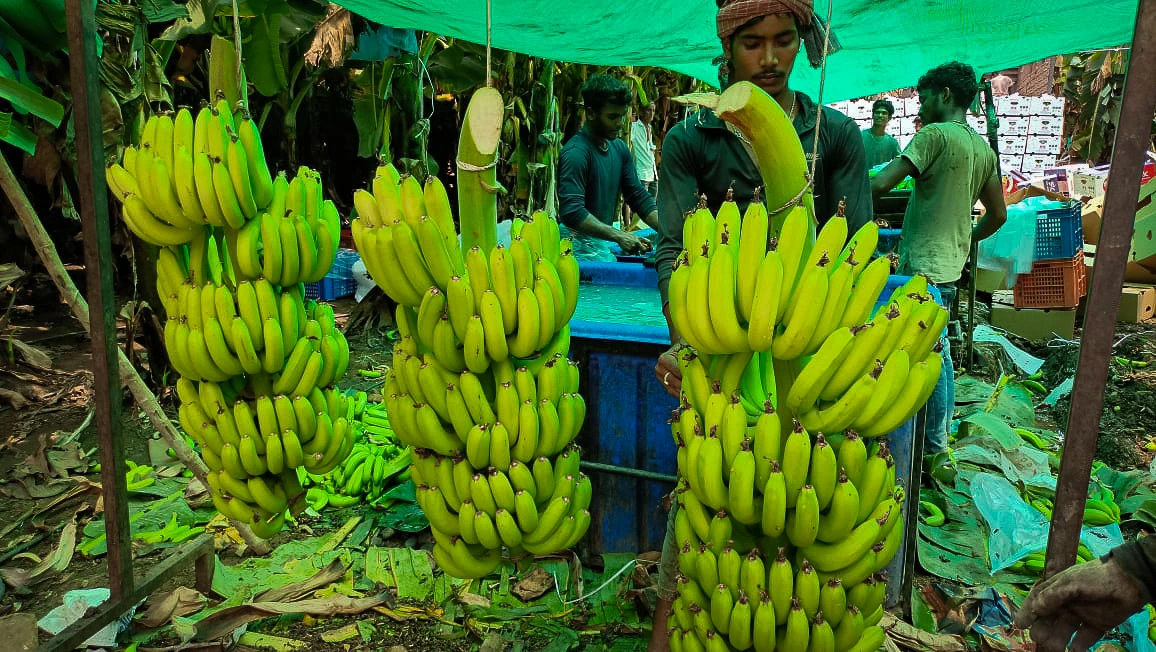
A 2023 study published in the International Journal of Research in Engineering, IT and Social Sciences states that economic shifts have made farming less attractive for the next generation; fewer families rely on it as their sole livelihood, and across the district, the educated sons and daughters of farmers are looking to cities or low-wage jobs for steadier pay. Still, most banana growers are university graduates, deeply invested in ancestral land, and many endure, working on small plots but earning more than ₹2.5 lakh a year. They persist against mounting climate uncertainty, rising costs, erratic markets, and bouts of crop disease and pest damage.
For years, Suresh Patel, a farmer from the neighbouring district of Nandurbar, would watch in horror as up to 80% of his plantation was flattened in a single night. But everything changed in 2025, when Suresh embraced Phule Pride—a wind-resistant variety developed locally—and paired it with smarter farming practices. Using cluster staking, lines of bamboo as windbreaks, and mobile weather alerts from his cooperative, Patel not only preserved his crop during the March storms but also managed to harvest 20% more than before.
The Phule Pride variety was born out of seven years of research at the local Banana Research Centre and has been field-tested since 2018. Unlike its globally dominant parent Grand Naine, Phule Pride stands a little shorter, its stems thick and resolute. It doesn’t just survive wind—it thrives, shrugging off lodging, resisting the fatal fungal disease of Sigatoka leaf spot, and maturing almost a month earlier than rivals. Although its yield (98 tonnes per hectare) trails Grand Naine by a whisker (which averages 110 tonnes), Phule Pride promises a complete harvest; every bunch makes it to the market, and cultivation costs stay low. The result: higher net returns and a farm that’s storm-ready.
The Phule Pride variety was born out of seven years of research at the local Banana Research Centre and has been field-tested since 2018.
Since 2021, tissue culture labs in Maharashtra have been successfully meeting the growing demand for its saplings among farmers. Progressive young farmers like Hitesh Mahajan in Raver couple it with summer-savvy practices—mulching, reinforced pits, clever intercropping—to safeguard every plant through the most punishing months.
“From staggered planting to post-harvest innovation that transforms even rejected bananas into profit, we’re equipping farmers to not just grow more, but earn more. India must lead not only in production, but in global banana exports, with trained, organised growers capturing full value from every fruit,” emphasises Dr Patil.
A quiet transformation spreads across Khandesh. As intensive banana planting grows, farmers also sell tubers for extra income. The demand for high-yield seedlings now outpaces large-scale supply efforts for both Kandebag and Mrig Bahar seasons. Nearly half the district’s banana acreage is under intensive systems, double from a few years ago, signalling that Jalgaon’s moment as India’s banana capital continues. Modern varieties, smart agronomy, and community cooperation point the way ahead, even as challenges remain.
Also read: Syed Ghani Khan’s orchards guard mango treasures from Tipu Sultan’s reign
{{quiz}}
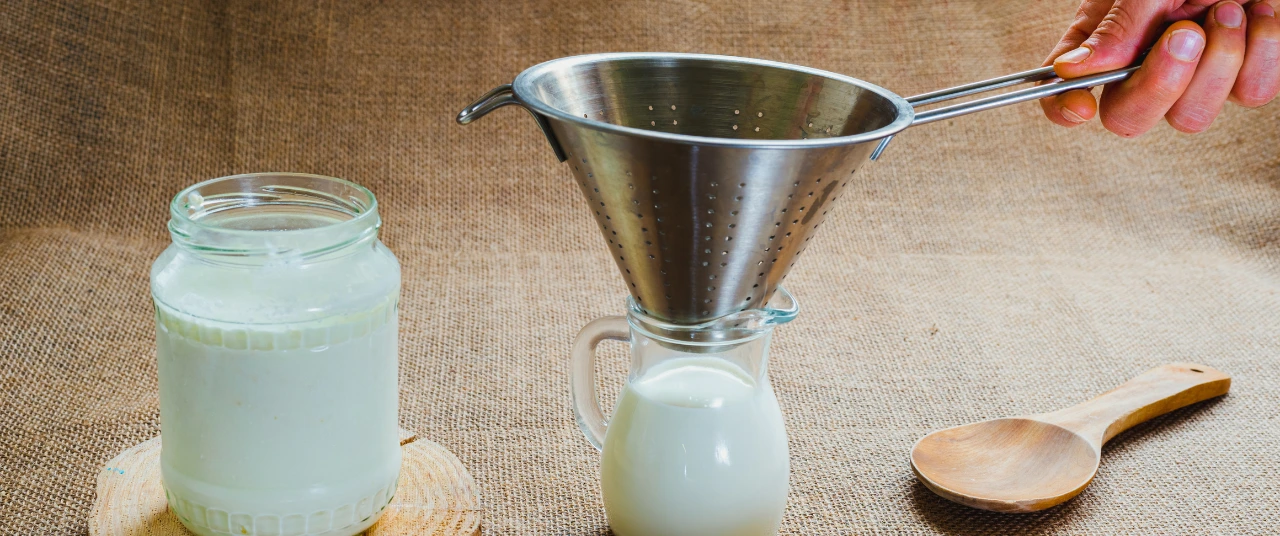
High-protein milk simply concentrates the full range of proteins naturally present in milk
Editor's Note: From grocery lists, to fitness priorities, and even healthy snacking, protein is everywhere—but do we truly understand it? In this series, the Good Food Movement breaks down the science behind this vital macronutrient and its value to the human body.
For many of us, the word ‘high-protein’ conjures up images of shaker bottles, supplements, or even tubs of whey powder. But in the past few years, supermarket shelves have introduced another option: high-protein milk. It looks like regular milk, tastes like regular milk, and yet somehow promises nearly double the protein. This has naturally led to the assumption that high protein milk must be fortified with whey powder. Whey is the watery liquid left over when milk curdles, and the solids (curds) are strained out; whey powder, the concentrated protein extracted from this liquid has, in turn, become synonymous with gym culture and quick protein hits.
But high-protein milk is built on a very different principle, one that preserves the pre-existing balance of proteins found in milk rather than isolating and concentrating only one part of it. Instead of adding isolated whey proteins, which would change both its taste and the way our bodies may digest it, high-protein milk simply concentrates the full range of proteins naturally present in milk.
To understand this distinction, it helps to look at what milk contains. Cow’s milk carries two main proteins: casein and whey. Casein makes up the majority of this content, forming microscopic structures called micelles that stay suspended in milk. Whey makes up the remaining fraction and stays dissolved in the liquid.
This difference sets up the key contrast between proteins that remain blended in this manner (like those found in milk, where casein and whey co-exist) and isolated proteins (like whey powder, which extracts and concentrates only the whey fraction from milk). Blended proteins are digested across different speeds and durations; isolated proteins act quickly and intensely.
Also read: Whey to go: A complete guide to protein
High-protein milk keeps this natural casein–whey blend intact. Instead of adding isolated protein, producers run fresh milk through a process called ultrafiltration. Think of it as a very fine sieve: water, lactose, and some minerals pass through, while the larger molecules of casein and whey stay behind. When the retained portion is recombined, you end up with milk that has more protein per millilitre and a higher calcium concentration (calcium is bound to casein micelles, which the process of ultrafiltration retains). Meanwhile, it keeps the original casein-to-whey ratio more or less intact.
This is the crucial distinction. Whey powder also uses ultrafiltration, much to the same degree. However, in contrast to high-protein milk, where ultrafiltration is applied to whole, fresh milk, only the whey liquid, where casein has already been removed in the curds, is subject to this process in the making of whey powder. Hence, unlike whey powder, which strips away the casein and delivers only the fast-acting part of milk’s protein, high-protein milk makes denser the full protein profile naturally present in the milk.
High-protein milk, by retaining this natural blend and simply concentrating it, supports both immediate recovery and longer-term maintenance,
This matters because the human body responds differently to blended proteins than to isolated ones. Whey is rapidly digested. So when you consume whey—an isolated protein—alone, you get a sharp, immediate rise in amino acids. This is excellent after a workout, when your muscle tissue is primed to repair itself. But that benefit lasts only for a limited window.
Meanwhile, casein digests slowly because it forms a soft curd in the stomach, giving a prolonged, steady release of amino acids. With its slow-release, casein stretches this window out. This is why research often describes the natural combination of casein and whey found in milk as offering both a ‘burst’ and a ‘supply line’ of amino acids. High-protein milk, by retaining this natural blend and simply concentrating it, supports both immediate recovery and longer-term maintenance, making it useful for people who want to tailor their protein intake to not just to workouts, but also to the long-term strengthening and functioning of the body—like steadier blood pressure, boosted immunity and bone development.

Also read: Protein traceability: Why knowing where your milk and pulses come from matters
When evaluating these two sources of protein, there’s also the question of how the body uses this nutrient throughout the day. The broader science around muscle protein synthesis (MPS) indicates that our muscles respond best when we give them moderate amounts of high-quality protein at regular intervals. Since high-protein milk behaves like milk—just denser—it can be slotted naturally into meals and snacks without taking a supplement. In practical terms, this makes it easier to distribute protein intake across breakfast, lunch, and dinner, a strategy that supports better synthesis and reduces the peaks and troughs that come with having most of our protein during the heavier meals of lunch and dinner.
High-protein milk, however, also has its limitations. Since it’s still milk, it retains lactose unless the manufacturer removes it separately—making it unsuitable for people with lactose intolerance. And while it offers more protein per serving than regular milk, it can’t match the sheer density of whey isolate, which is designed for people who need a large protein dose without extra fluid, fat, or carbohydrates. Its value lies elsewhere: as a whole-food, everyday option that fits naturally into the diet without leaning on supplement logic.
In the landscape of high-protein eating, it is easy to collapse all protein sources into the same bucket. But understanding the difference between high-protein milk and whey powders reminds us that how protein is delivered is as important as how much of it we consume. One is a concentrated version of a food we already understand; the other is a targeted supplement engineered for speed and a low protein-to-calorie ratio. Both have their place, but if your goal is to eat more protein embedded into your natural diet—with a balance that supports sustained recovery, fullness, and steady muscle maintenance—high-protein milk may fare better for your body.
Also read: The ‘right time’ to eat protein: Little and often, rather than in one meal
Please try another keyword to match the results
